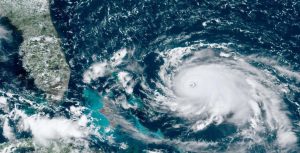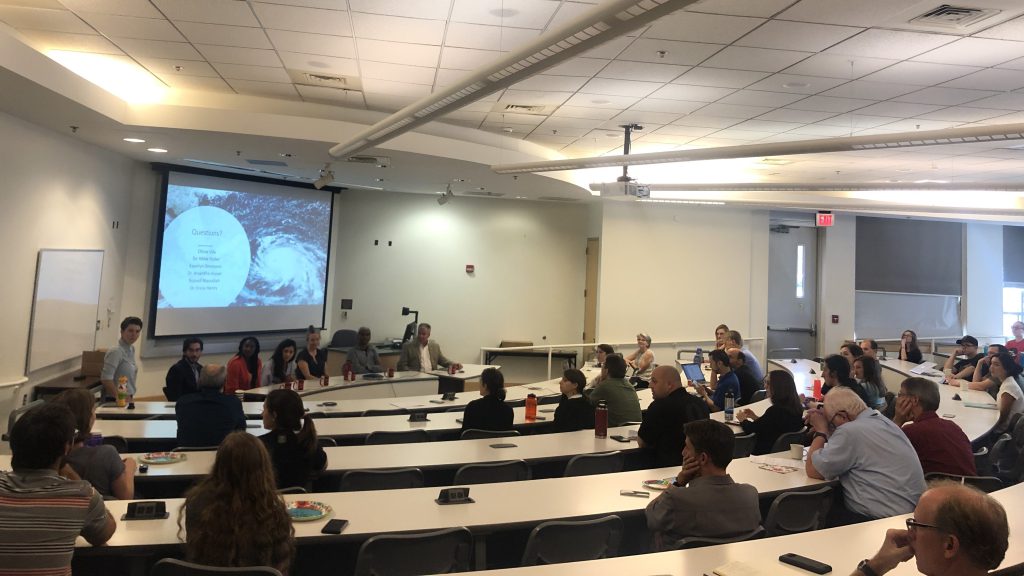Seminar Panel Demonstrates the Disciplinary Diversity of Hurricane-related Research

This post was written by Kate Jones, a 2019-20 Global Change Fellow. It summarizes the first of six seminars in the Global Change Seminar series for this academic year. The Global Change Fellows hosted a panel discussion on September 26, 2019, drawing speakers from across the university to discuss the many lines of research that address hurricanes and their impacts in a changing climate. If you were unable to attend, a recording of the seminar and panel discussion is available here. The next Global Change Seminar will be held on October 31st from 3:30 – 4:30pm.
Panelists:
Dr. Anantha Aiyyer, NCSU Marine, Earth, and Atmospheric Sciences
Dr. Erica Henry, NCSU Applied Ecology
Russell Nasrallah, NCSU Civil Engineering
Kayelyn Simmons, NCSU Marine, Earth, and Atmospheric Sciences
Olivia Vila, NCSU Parks, Recreation, and Tourism Management
Dr. Mike Yoder, NC State Extension
Moderator:
Rachel Sussman, NCSU Marine, Earth, and Atmospheric Sciences
 In the last decade, five notable hurricanes have made landfall in North Carolina. Dorian, the most recent of these hurricanes occurring only early this month, devastated several North Carolina coastal communities. In its wake, Dorian has sparked critical questions about adaptive capacity in both coastal and inland communities. The impacts from these storms range from loss of life, disrupted transportation networks, power outages, contaminated water sources, damaged infrastructure, loss of livelihood for individuals that make a living from the land or seascape, and loss of economic opportunity, particularly tourism. These hurricane-induced disasters transcend state and national boundaries, increasing the difficulty when developing mitigation policies and ensuring equitable resilience for all impacted communities.
In the last decade, five notable hurricanes have made landfall in North Carolina. Dorian, the most recent of these hurricanes occurring only early this month, devastated several North Carolina coastal communities. In its wake, Dorian has sparked critical questions about adaptive capacity in both coastal and inland communities. The impacts from these storms range from loss of life, disrupted transportation networks, power outages, contaminated water sources, damaged infrastructure, loss of livelihood for individuals that make a living from the land or seascape, and loss of economic opportunity, particularly tourism. These hurricane-induced disasters transcend state and national boundaries, increasing the difficulty when developing mitigation policies and ensuring equitable resilience for all impacted communities.
Climate change only magnifies the uncertainty and complexity of managing for long-term preparedness. In the context of a changing climate, major scientific questions still surround the possible non-stationarity of future hurricane characteristics such as intensity, frequency, moisture content, and expected trajectories. Moreover, how could a slight shift in any of these characteristics exacerbate hurricane impacts? How do these impacts influence less anthropocentric themes, such as biodiversity, migrations, and extinctions? Motivated by these questions, the Global Change Fellows sought experts at NC State University that could paint the broader context of hurricanes in a unique way, while sharing knowledge from diverse disciplines.
Demonstrating the diversity of disciplines studying hurricane-related topics, six experts from across the university came together to provide anecdotes of hurricanes from their field and discuss broader management actions and the future of hurricane research within their respective disciplines. The seminar was formatted as back-to-back lightning talks, in which each of the six participants had exactly five minutes to speak, and all questions were reserved for a panel discussion at the end.
Olivia Vila, a doctoral student working with Dr. Bethany Cutts, began the lightning talks discussing a portion of her dissertation work. Her talk focused on Project BRIDGE: Building Resilience and Innovation Through Diverse Group Engagement. Project BRIDGE began in Robeson County, NC, following Hurricane Matthew. The goals of Project Bridge were to initiate a Citizen Science program and raise awareness of contaminants, such as E. coli, that can be more prevalent after flood events. Vila and others set out to collect soil samples, interface with communities through interviews, and better understand perceptions of post-storm risks across communities. They found visible risks such as mold were discussed more frequently and confidently when compared to non-visible risks, such as bacteria. Understanding the baseline of community awareness, developing relationships, and collecting the initial soil samples help create a strong foundation for future work in Robeson County to facilitate community resilience and participatory disaster response.
Mike Yoder, Associate Director of NC State Extension, Coordinator of Emergency Programs and State Program Leader for 4-H, eloquently summarized the role of NC State Extension in disaster management in five minutes. Yoder’s talk provided exceptional perspective on the weighty and difficult decisions facing emergency management on the ground during a hurricane, as well as the quandaries managers are thinking about for long-term community health and sustainability in a changing climate. Yoder is a key piece in the process of NC State Extension efficiently disseminating information to administrators responsible for allocating resources before, during, and after a disaster. Their concerns range from the hospital that loses power during an event to the farmers that could lose the future viability of their land due to repeated, high-intensity events. To address these disparate responsibilities, extension employees focus on tackling applied issues by interfacing with local communities, but are also backed up by a team of researchers that focus on current unknowns and long-term change.
Kayelyn Simmons, a doctoral student working with Dr. David Eggleston, shared her work on underwater acoustics in pre- and post-hurricane environments. Differentiating between abiotic (ships) and biotic (sea life) acoustics and filtering the biotic acoustics at different frequencies allows researchers to identify diversity and abundance of soniferous species (species that produce or conduct sound). Simmons and others are able to detect what an average day of acoustic signatures is for a given site and compare this to the acoustics at varying temporal intervals following a storm. Simmons is able to identify the “exit” of species from shallow to deeper water as the barometric pressure drops before a hurricane, and then, track the return of activity to a site after the storm has passed. This return of species is intuitively related to storm intensity. Correlating acoustics to other factors, such as reef damage decreasing the acoustic signature, allows Simmons to apply these acoustic studies to compare overall diversity and health of managed vs. unmanaged fisheries or set baselines for conservation practices.
Dr. Anantha Aiyyer, an Associate Professor focused on atmospheric dynamics, presented work that developed out of a student’s class project – a testament that interesting research findings and questions can crop up at any point in the scientific process. The work builds on general findings that indicate hurricanes are slowing down, likely related to warming, and slowing global circulations; but specifically, Dr. Aiyyer is interested in the acceleration of hurricanes. The acceleration of hurricanes influences their ability to transition from tropical to extratropical storms. Hence, changes in hurricane acceleration may influence their ability to impact more middle and northern latitudes. Yet, understanding the acceleration and occurrences of extratropical events is not entirely dependent on changing global circulations – there is inherent stochasticity due to weather at finer temporal scales. A better understanding of these weather forcings is necessary to predict the likelihood of extratropical events with climate change.
Russell Nasrallah, a master’s student working with Dr. Elizabeth Sciaudone, uses numerical models to look at highway vulnerability to large storms along the North Carolina coast. His work is motivated by the limited number of roadways on and off of barrier islands and the large volume of tourists that can be on the island at any given time. Using a wave-driven sediment transport model, Nasrallah is able to simulate storm scenarios and predict whether the present dunes will be sufficient barriers, are moderately eroded, or are overtopped, impacting the highway with varying severity. The North Carolina Department of Transportation (NCDOT) will use Nasrallah’s work for transportation planning and disaster preparedness efforts. The model outputs also quantify the amount of dune erosion during an event, so the NCDOT can better estimate the amount of dune rebuilding and fortifications that may be necessary after a given storm.
Dr. Erica Henry, a postdoctoral research associate, studies habitat availability for the extremely rare Miami blue butterfly. The habitats are pine-dominated limestone “ridges” in the Florida Keys. This habitat is rare in natural environments, and the occurrences in human-dominated landscapes are in dense, highly fragmented urban areas. This complicates things because fire is one of the most effective agents to create Miami blue habitat in the Florida Keys – but difficult to implement regularly in urban locations. Henry set out to perform a plot-scale study to understand the efficacy of alternative management actions for restoring Miami blue habitat (i.e. mechanical clearing of trees and understory). With impeccable timing, Hurricane Irma struck the Florida Keys, burying Henry’s newly designed plots with storm debris. Unfortunately, no Miami blues have been observed at the site since the hurricane, but valuable lessons were learned about the role active management can play in habitat restoration and resilience. In Henry’s post-hurricane observations, she found that unmanaged sites were least resilient to maintaining possible habitat when subject to the devastation of the hurricane. One of her takeaways from this study is to “do the scary management,” such as burning or other intensive or expensive operations. Choosing to manage could be the key to habitat resilience (and preventing extinctions!) in post-disaster landscapes.
The most enriching aspect of the seminar was the interactive, two-way sharing of knowledge between the audience and panelists. Questions, when appropriate, were diverted to experts in the audience to maximize the interdisciplinary dialogue amongst the 65 people in the room and the 20 online participants. The Global Change Fellows would like to thank those who attended the seminar online and in person; your participation continues to make these events distinctive and engaging. Additionally, thank you to the individuals who dedicated time and resources to planning this seminar. We look forward to the second seminar in October!

View a recording of the seminar.
- Categories:
